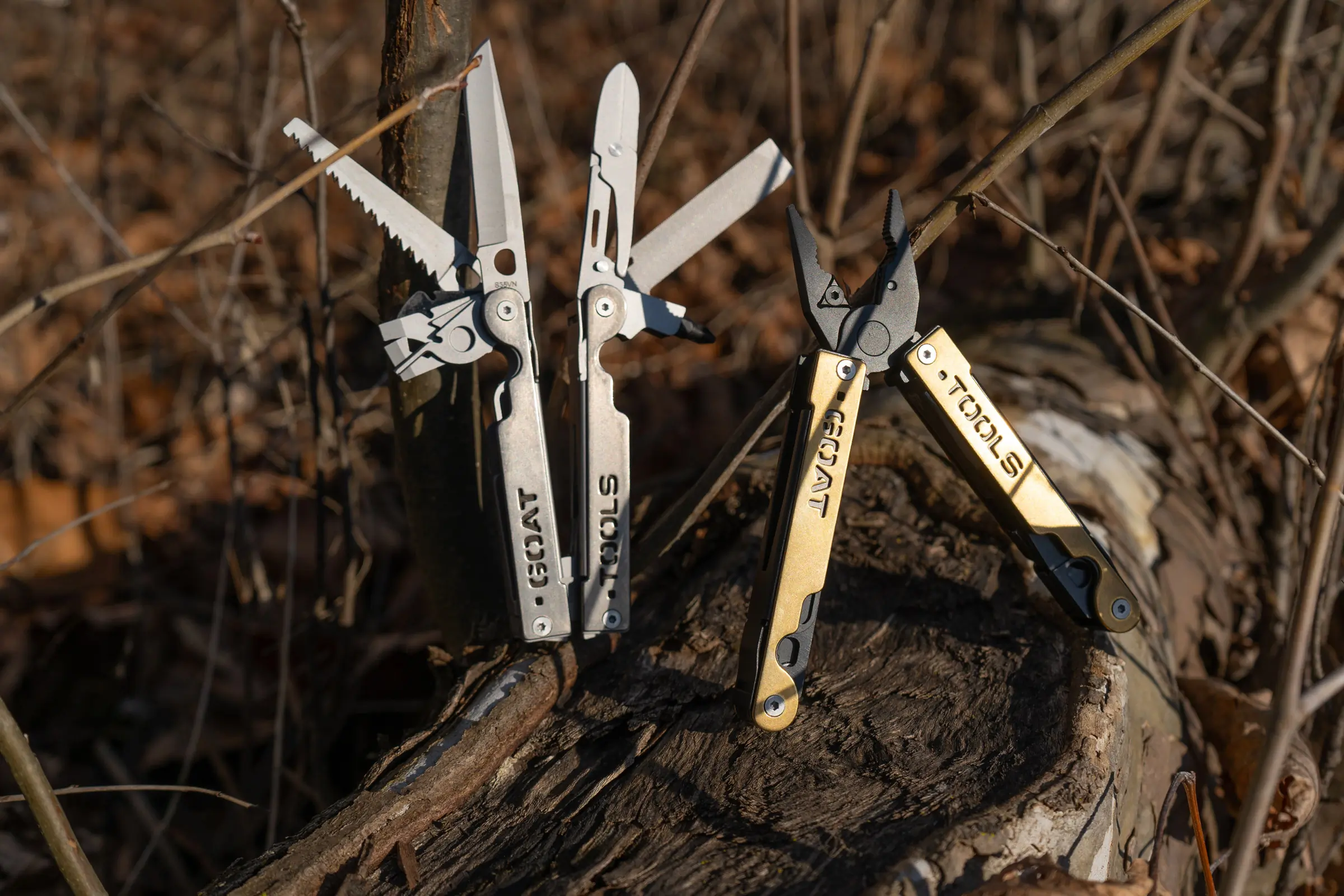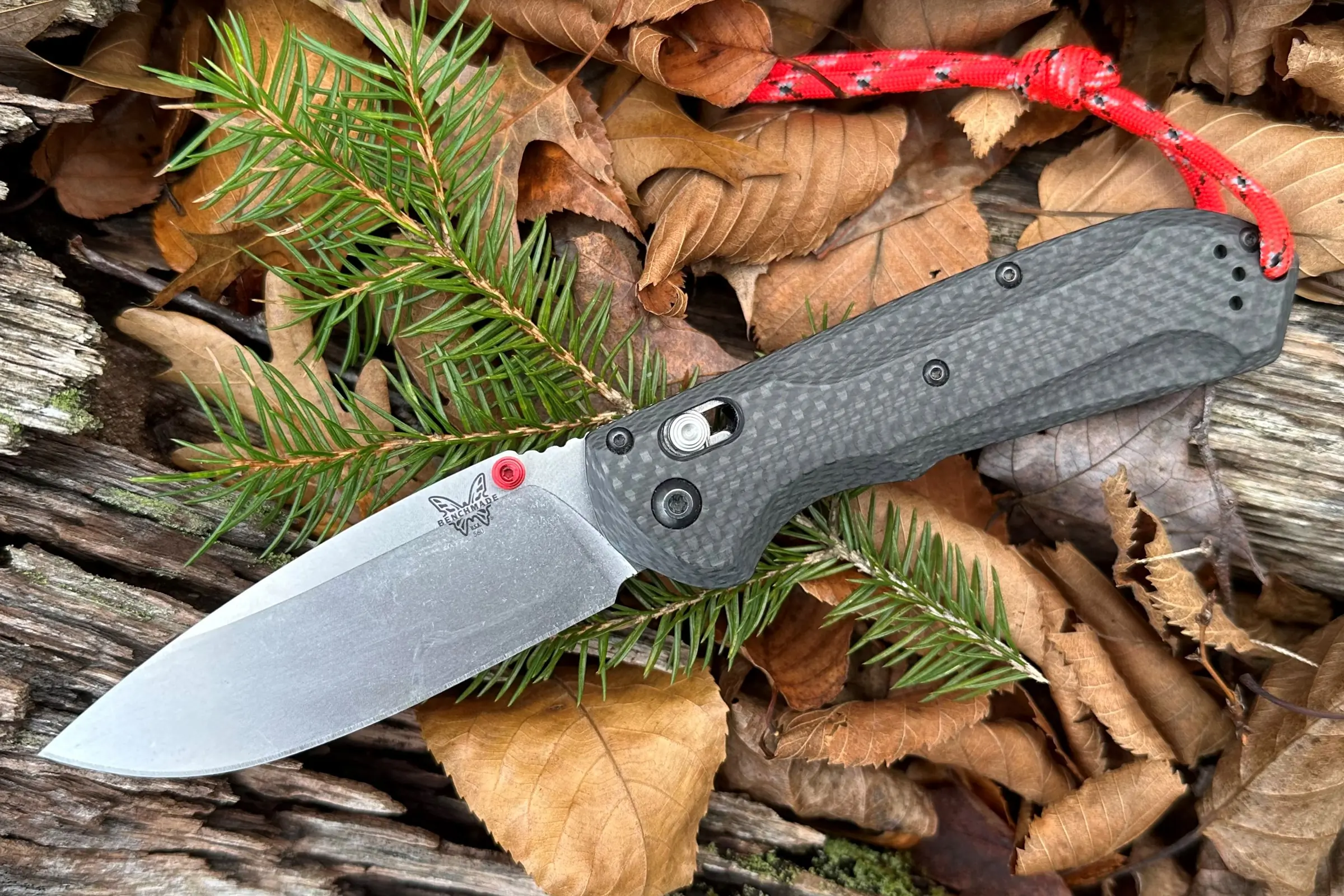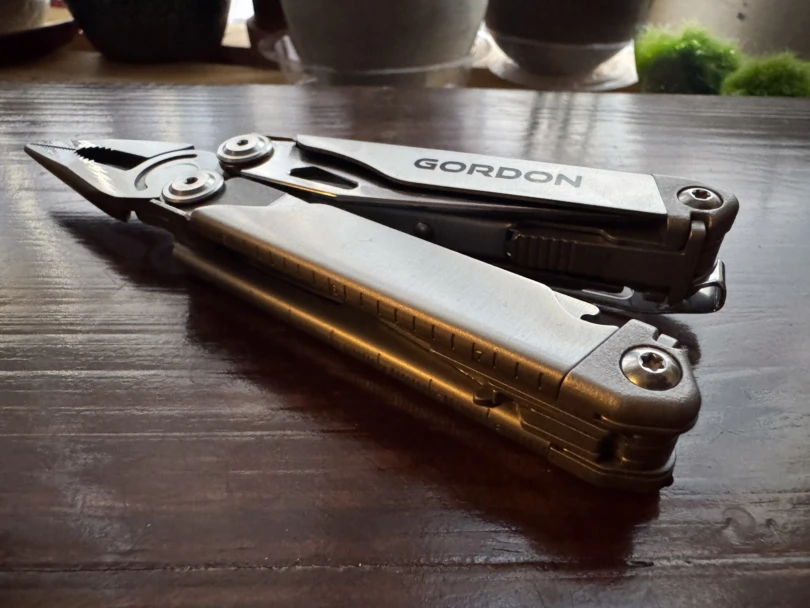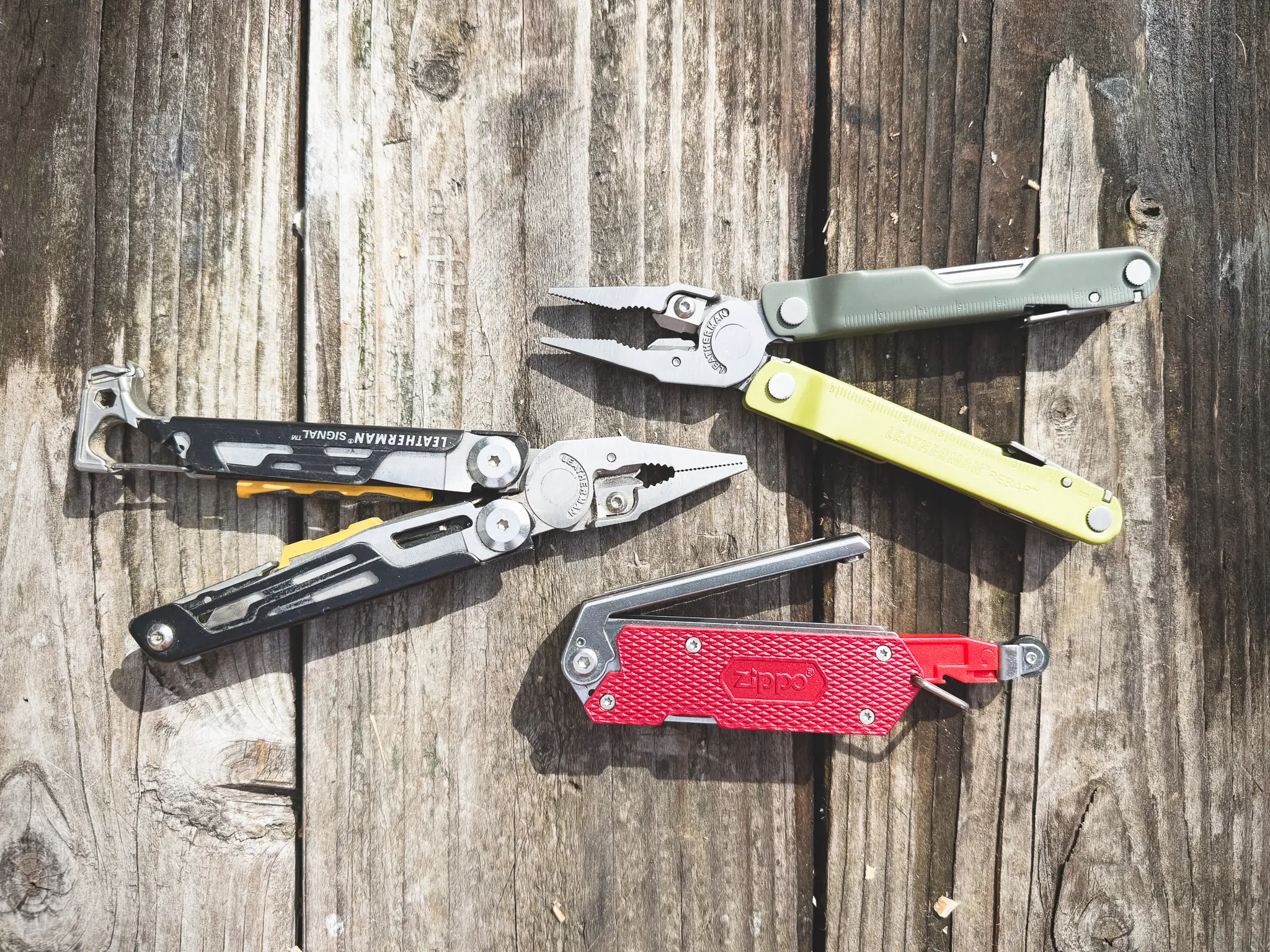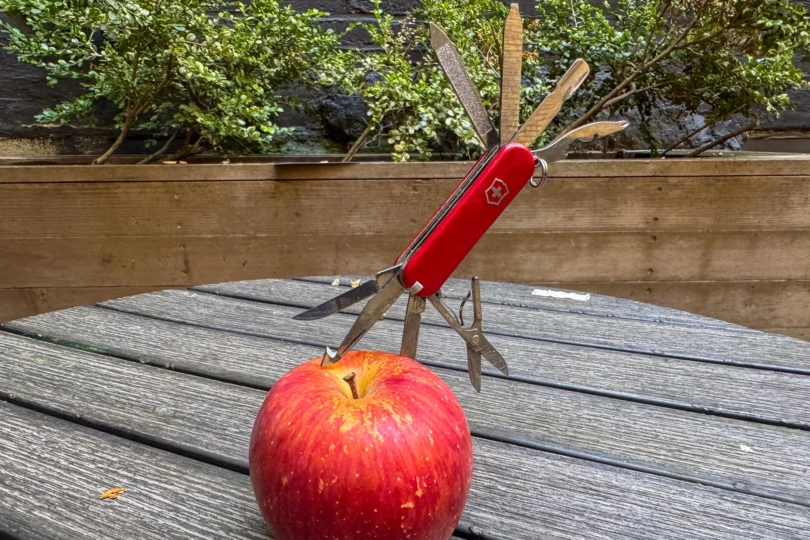I’m never satisfied. I pack and repack my bags for ever-slimmer margins of improved gear accessibility. My camp cook set has half a dozen DIY firestarters, each theoretically better than the last. I completely regrind every knife I own, and I often swap or modify handles.
After all, if my EDC blade doesn’t sport a microbeveled, mirror-polished edge, aftermarket ceramic bearings, and a hand-contoured, gold-inlay carbon fiber handle (this is an actual description of my EDC Zero Tolerance 0452 CF) — is it truly optimized?
Who knows many times I’ve thought, “If only my (insert EDC here) could do this!” There is a reason I write for GearJunkie. I’m a gear nerd and knife fanatic. So, I must admit some bias: I am exactly the kind of person that GOAT Tool’s Multi-tool was made for.
I’ve dreamed of a customizable multitool for ages. I’ve swapped features on other standbys for years. However, the GOAT is the first multitool where every tool, besides the pliers, can be fully and easily swapped. With a little bit of planning, and without any other tools, you can have a multitool loadout customized to your needs.
But the question is: can you really have it all?
In short: The GOAT (ostensibly short for the “Gear of All Trades,” not “Greatest of All Time”) is the world’s first multitool that can be almost completely customized: alternative scales, knives, scissors, Allen keys, screwdrivers, etc. However, the tradeoff for flexibility-first engineering is a few handling peculiarities that make some tools less user-friendly — especially for EDC newbies.
Shopping for a multitool? For more info, check out GearJunkie’s guide to the best multitools.
- Weight: 7.7 oz.
- Knife steels: 440C or S35VN
- Standard MSRP: $119
- Standard tools: Combination pliers, wirecutters, hobby blade, 10mm wrench, medium flathead, knife, ¼ in bit-driver, 2mm Allen/hex key, saw, awl, scissors, small flathead
- Bundle MSRP: $362
- Bundle extras: S35VN Blade, bronze scraper, metal file, gut hook/safety cutter, replacement wire cutters, 3mm and 5mm combo Allen key, brass scales, titanium scales, serrated blade, bottle/can opener
Pros
- Fully customizable
- Relatively lightweight
- New tools constantly being developed
- Flat, hammer bottom
- Optional aesthetic scales
- Quick-snap MOLLE-compatible sheath
Cons
- Not one-handed operable
- Difficult to deploy one tools without others opening
- Complicated to unlock and stow tools
- Obtuse wirecutters
GOAT Tools Multi-Tool Review

Concept and Design
The tools on most multitools work something like this: Drill a hole through the base of each tools. Run a pivot through them. Have some sort of locking mechanism or spring-tensioned, slipjoint-like system that keeps the tool in place while you’re using it.
The GOAT keeps the pivot. However, instead of a hold drilled through the base of tools, it has a cutout in each tool. This leaves the base of each tool looking like a “C,” which can slot onto the pivot.
A small hook in the base of each tool catches a cutout in a spring lock bar — keeping every tool secure when deployed. To close tools, a small tab on the left side of each group of tools, when lifted above around 30 degrees, disengages the lock. But with both the tool and pull tab fully deployed, that C-shaped groove allows you to slide any tool out, and swap it for another.
EDC Use and Handling




For some, having to lift another level to disengage a tool might sound already a little complex. Certainly, it does make most of the implements on the GOAT Tool two-handed. However, there is a workaround: pushing firmly down on the other tools in each housing does depress the lock bar on the other side enough for you to disengage a given tool.
I quickly found myself using this, instead of the lever. The downside of having a hot-swap system without any washers between the tools is that, whenever you try to open one tool, others try to come along for the ride.
In theory, the operation goes: “Open any given tool. Pull the lock disengagement tab. Start closing tool. Close tab. Close the tool.”
In my experience, the operation went more like, “Start opening a tool. Push down the other tools that thought they were called to attention. Finish opening tool. Open the lock disengagement tab past 30 degrees. Start closing tool. Push and hold the tab down. Close tool.”
Disengaging the lock by just depressing the other tools, made for a satisfying shortcut.
Already, this is probably too finicky for some who want a simple, deploy-at-the-ready multi. But there was plenty more testing to be done.
Finish, Fidgeting Factor, and FUBAR
Tight tolerances, myriad moving parts, and the buttery smooth deployment of quality spring-loaded pliers are a potent combination for those with ADHD minds and fidgety fingers — which is how I cut myself for the first time in almost a year.
The knife and optional hobby blade, as the longest and thinnest tools, would occasionally catch on the spring bar for the pliers. This would only happen when I opened the tools one-handed, as the sideways pressure from my thumb would push the tips of these tools beneath the spring bar for the pliers. I found myself wishing for slightly larger cutouts for these tools to prevent this.
Fortunately, slightly tightening the pivot screws mostly solved this. However, this was an accidental solution. While slinging the pliers open and closed like an ’80s movie butterfly knife bad guy, I discovered that the pivot screws weren’t tight enough to keep the knife from deploying when flick-opening the pliers at top speed.
One cut and a few twists of the 2mm hex key built into the tool for maintenance, and I found two problems solved by just as many screws. I did discover one more problem, though: Having found the most satisfyingly flicky multitool pliers I’ve ever operated, I am now tempted to become a butterfly knife collector.
Plying Its Trade




Like most non-Swiss Army Knife multitools, the heart of the GOAT is its pliers. Spring-loaded grippers often get a bad rap where multitools are concerned. The GOAT, however, is an example of spring pliers done well.
They aren’t as nimble as the needle-nosed combo pliers of Leatherman classics like the Surge and Wave+, and they aren’t as stout as, say, the slip-joint pliers of the Gerber Dual Force. They aren’t quite precise enough to be my new resident tacklebox pliers, or beefy enough to be the first thing I grab for a rusty fastener. For everything else in between, though, they work very well.
After 2 months of going as far out of my way as possible to use them, the teeth aren’t showing the slightest bit of wear. Even with stubborn fasteners, the handles were never uncomfortable. They aren’t quite as rounded as the industry standard Wave+, but the longer handles and wider body (with the additional handle scales added on) filled my hands better.
The pliers’ wire cutters, however, did come up short. Instead of the carbide cutters used by most high-end (non-Victorinox) multitools, the GOAT opts for hardened steel cutters. It’s a fair trade. Replaceable steel cutters will dull faster, but will be cheaper and less prone to chipping. With triangular, three-bladed cutters, akin to the ones on Gerber’s Center Drive, when one side gets dull, it allows you to rotate the cutters to fresh faces.
Unfortunately, each of those faces was too steep to cleanly cut wires. Granted, I still cleaved through clothes hangers (with considerable effort) — but no wire escaped the GOAT without equal parts squashing and cutting.
A Cut Above




Where the GOAT’s individual tools really started to shine is with their blades. Geometry-wise, the blade is relatively comparable to the Leatherman Wave+, but thinner and slicier behind the edge, opting for a straighter spine and a bit more belly. Notably, with the thumb hole extending so far into the blade, the GOAT’s knife — despite being almost identical in length to the Wave+ — has less usable blade length.
Swap it out for the S35VN blade, and it becomes an absolute beast. Typically, for me, multitool knives are beater knives — and rarely would I abuse S35VN. It’s a steel that trades edge retention for being a bit prone to chipping.
But at $24 for replacement blades that come shaving sharp and hold an edge well, I found myself cutting with abandon. The GOAT has the first multitool knife I would grab over my favorite folder for packaging tape.
Sticks needed feathering? GOAT Tool. Box had staples that could chip my wallet-draining S90V knife? GOAT Tool. As a devout “knife guy,” it is with a mixture of shame and serendipity that I admit that for 2 months, I used the GOAT’s blade more than any of the folders in my pocket rotation.
Likewise, as a knife guy, I never would have thought that I’d have much use for a hobby blade — until it came time to put up window insulation. I realized that I could simply pop the multitool off for, essentially, a fully capable precision blade.
Traveling to a place that doesn’t allow locking blades? No biggie. GOAT offers nonlocking versions of its main blade. The optional safety cutter offers even more travel freedom, being carry-on-legal. Moreover, it’s among the sharpest safety cutters/gut hooks I’ve ever handled.
For forgetful travelers, field-dressing hunters, those looking for seatbelt cutters for their glovebox multitool, or even just those who open a lot of packages in a knife-sensitive workplace, the safety cutters are a wonderful addition.
Serrated, Saw, and Scissor Tools




Being Southern-raised, Midwest-trained, and a wood stove camper in snow and rain, a good saw is, to my mind, a must-have for any outdoor multitool. Here too, GOAT more than passes muster, with a saw largely comparable to that old standby, the Leatherman Wave+. The GOAT’s saw cuts a little less aggressively, but being stouter tends to bind and bend less when cutting quickly.
The GOAT’s serrated blade was truly remarkable — in that, as someone who philosophically disagrees with the existence of serrated blades on any tool that already has a saw and knife, I could, for the first time ever, remove it within 5 minutes of opening.
All jokes aside, the GOAT has one of the largest, most capable, and most comfortable scissors of any multitool I’ve ever used. It was more than capable of trimming herbs and clipping the thicker zip ties I use to bind cables and set up accessories on a new Hennesy hammock alike. However, it didn’t do so without some quirks.
The scissors didn’t lock, and the spring didn’t engage automatically when deployed. Rather, they had a three-stage deployment: Deploy the scissors. Open them. Push the spring. Then they would finally snap fully to.
While the scissors handled small twigs and zip ties, the spring would disengage when encountering harder objects, like fingernails. (Don’t pretend. If you’ve owned a multitool, you’ve done it too.) And being a two-piece tool, the scissors were the hardest implement to attach and detach from the multitool.
Where the GOAT’s toothier implements fell genuinely short was with the file. If you’re looking to realign the rolled edge on the soft steel of, say, a Fiskars hatchet, it’ll get the job done. However, the steel is too soft and the teeth too nonaggressive to stack up against most competitors — let alone gold standards like the Wave+’s half-crosscut, half-diamond file.
Drivers and Doodads
Arguably, in this day and age, one of the most useful implements on multitools, and, broadly, one of the implements with the greatest room for improvement, are drivers. Gerber’s Center-Drive currently holds the gold standard for a quality driver.
Leatherman used to offer the best multitool accessory: a ¼-inch ratcheting bit driver extension. However, those are now perpetually out of stock. Most of their multitool drivers aren’t offset enough for easy screwing and require proprietary bits.
So, the GOAT’s driver was a breath of fresh air. It accepts standard ¼ bits (making it compatible with that Leatherman ratcheting driver if you happen to have one). It’s generously offset, making it easy to screw things (!). And it sports a side-mounted magnet strong enough to actually retain an extra bit.
The rest of the flat heads and hex heads are a mixed bag. Various hex heads have different thicknesses, which can make hot-swapping tools a bit more complicated. The thicker 5mm hex key, for example, can require dropping two other tools.
Ingeniously, the 2mm hex key included on the tool can be used to help field-strip the multitool for maintenance. However, I found it necessary to use two 2mm hex keys to disassemble the tool — one to unscrew one pivot screw and another to hold the other still. The bundle includes another full, separate 2mm Allen key; however, I found both of them to strip a bit easily.
I was surprised to find that the multitool came stock with two flatheads, but no bottle opener — save for the pocket clips, which are certainly designed rock-solid enough to use as one. Both work well, but throwing a 10mm wrench cutout into the only flathead too large to be replaced by a bit could be a bit divisive for those worried about the strength of the tool.
But that’s where I return to the bit driver. Stripped the 2mm hex key? Rather swap the flatheads for a bottle opener and an awl, or, say, a bronze scraper for firearm maintenance? Easy! The MOLLE-compatible sheath has the space for a strip of extra bits. Carry the ones you want, and ditch the tools you don’t need for something more tailored.
Final Customizations




Let’s not pretend that EDC gear is purely functional. Everybody loves pretty things. In my case, “pretty” is a black oxide tool with brass scales. Do those scales serve much utilitarian function? Nope. They’re purely cosmetic add-ons (like other tools). Do they make me smile every time I pull the tool out? Very much so.
Granted, Leatherman and Gerber offer customization for their multitools, too. However, the range of handle scales and finishes offered by GOAT not only makes customization easy, it also makes it editable. Want a new tool next week? Swap the brass scales for titanium.
I got ahead of myself. I do think that a few tools, such as a ratcheting driver extension, tweezers, and a diamond/crosscut file combo would be a major boon. However, Leatherman has over 4 decades of R&D experience. Gerber has 85 years under its belt. Victorinox boasts 140 years of experience.
Future Considerations
At some point, with so many options, I found myself nitpicking.
If GOAT offered bundles of bits that could leverage the ¼-inch driver to replace some of the other tools, this would make the platform more flexible. If the brand offered a ratcheting extension, it could undercut Leatherman in that market.
Lastly, if GOAT made a thumb stud that could pop into the thumb hole for tools like the knife and hobby blade, they’d deploy more easily. Sure, tinkerers would love a precision driver. Backpackers will appreciate the flattened hammer bottom of the tool, but anglers might like a carabiner that would allow you to hang the pliers from a belt loop. All told: there’s room for improvement.
Yet, this Kickstarter company has successfully brought not just the world’s first fully customizable multitool, but a damn fine tool in its own right. It’s capable of hanging with standard-bearers like the Wave+, Center Drive, and SwissTool.
I found the GOAT far easier to field strip and maintain than any of its competitors. And, its components such as the S35VN knife, hobby blade, and safety cutter are truly best in class.
Not only that, but the company also plans to expand tools offerings, and maintains a Discord thread for people who want to stay in the loop on R&D. GOAT even has free 2D and 3D templates for tinkers who want to print or CNC their own handle scales. And everything is backed by a 100-year warranty. For anyone, let alone a startup, these aspects are incredibly impressive, and speak to passion as much as product.
GOAT Tools Multi-Tool: Conclusion
Would this be an ideal first multitool? Probably not. The tool deployment is fickle, and not as practical as you’d expect from an EDC — that’s the tradeoff to get the fully custom configuration you may be itching for. The GOAT has its fair share of idiosyncrasies. The biggest: it isn’t a one-handed tool.
But if you enjoy fidgeting with tools, tinkering, building, and optimizing things? Then the satisfaction you’ll get out of the GOAT will likely go well beyond just using it.
Instead of buying or needing multiple tools, or having to go with one multi-tool that only has most of what you want — you’d be able to order a multitool preloaded with exactly what you need. The single standard multitool is $119, all of the tools are fairly priced, and the bundle is more than worth it when on sale — so even with its quirks, the GOAT earns its title. We do hope to see a GOAT 2.0 iteration that makes the design and deployment even better.
